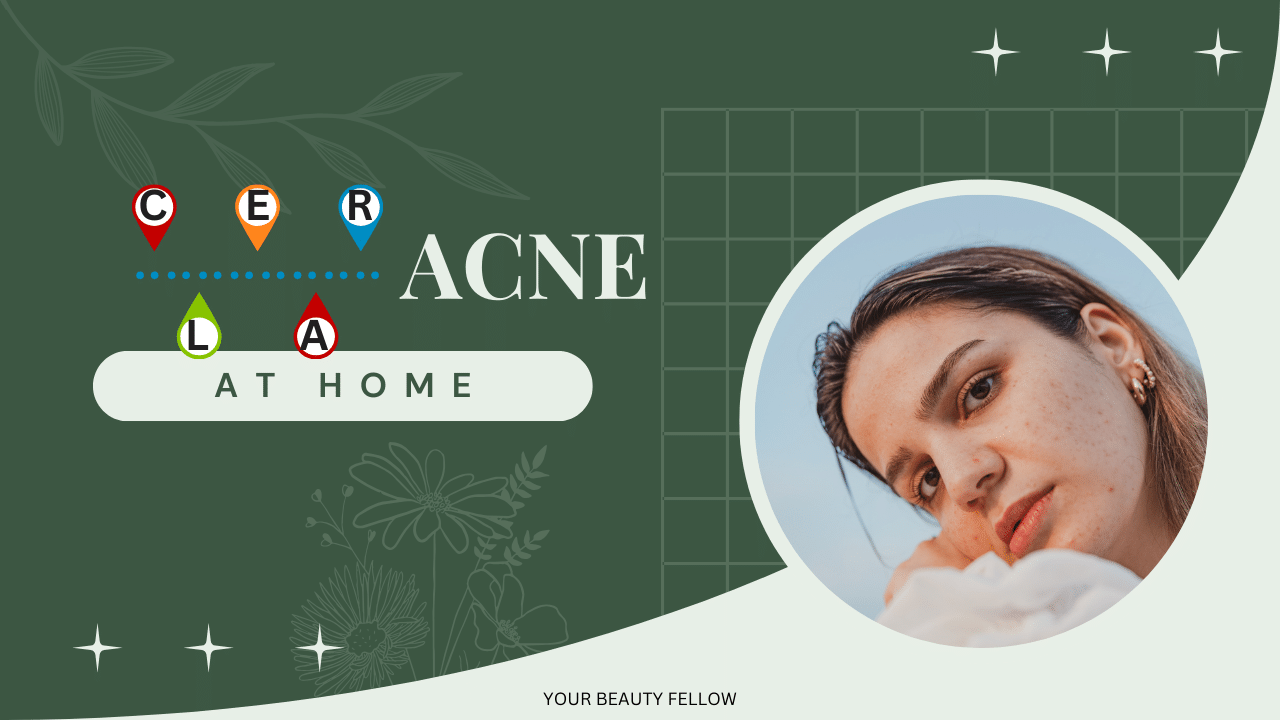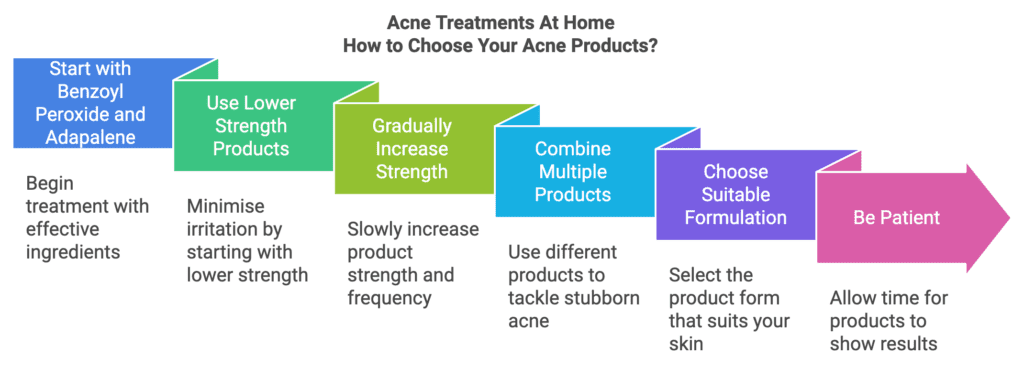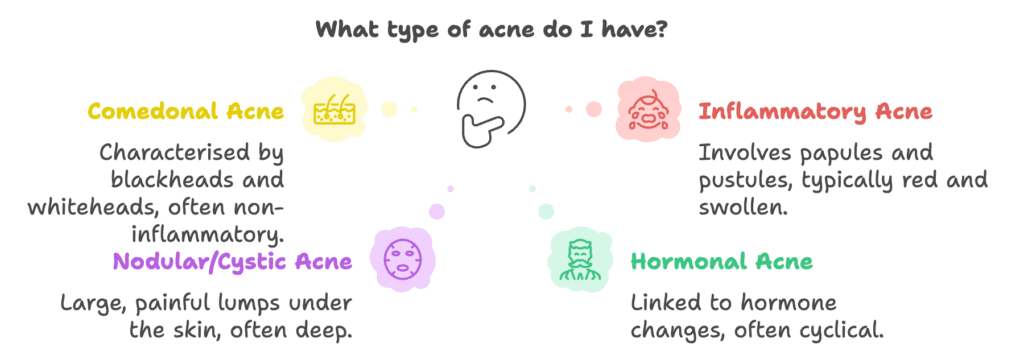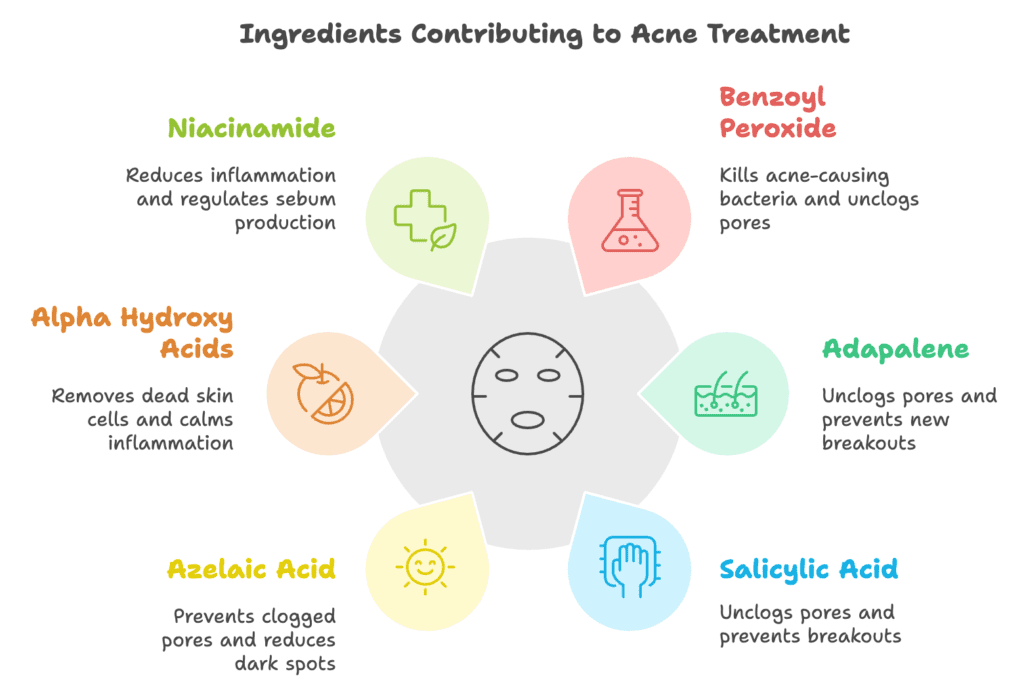
Acne can feel like an endless battle, especially when every product or treatment leaves you disappointed. The journey to clear skin often involves trying multiple products, following various routines, and, unfortunately, facing repeated setbacks. But what if there were a reliable, science-backed approach to guide you toward effective acne treatments at home that deliver lasting results?

Enter the CLEAR Skin Framework. With over a decade of skincare experience, I’ve seen countless people struggling with acne (even myself in the past), searching for a solution that actually works. This framework is designed to break down each part of the acne treatment process into manageable, evidence-based steps that address your skin’s unique needs.
In this guide, we’ll walk through the CLEAR Skin Framework in detail—covering top acne-fighting ingredients, step-by-step instructions, common mistakes, and how to build a routine that truly works for your skin type. You’ll learn not only which home remedies for clear skin are most effective, but also how to use them for maximum impact.
Understanding Acne
Before we jump into treatments, it’s important to first understand what acne is, what causes it, and how it affects the skin. Acne is a common skin condition characterised by clogged pores, inflammation, and the appearance of blemishes such as blackheads, whiteheads, papules, pustules, and nodules.
Acne is caused by a combination of factors, including:
- Excess Oil Production: The sebaceous glands in our skin produce an oily substance called sebum. When these glands become overactive, they can clog pores and create an ideal breeding ground for acne-causing bacteria.
- Clogged Pores: Dead skin cells, dirt, and oil can accumulate and block the openings of the pores, trapping bacteria inside.
- Hormonal Fluctuations: Changes in hormone levels, particularly androgen hormones, can stimulate the sebaceous glands to produce more sebum.
- Bacterial Overgrowth: A naturally occurring bacteria called Cutibacterium acnes (formerly Propionibacterium acnes) can multiply rapidly in clogged pores, leading to inflammation and breakouts.
- Genetics: Research has shown that acne can run in families, suggesting a genetic component to the condition.
Tips: Keep a log of your skincare and lifestyle habits to help identify your unique acne triggers. Knowing these can help tailor your treatment approach.
How to Identify Your Acne Type
Not all acne is the same, and treatments can vary significantly depending on the type. Understanding your acne type allows for a more targeted approach. The most common forms include:

- Comedonal Acne: Characterised by blackheads and whiteheads, which are caused by clogged pores.
- Inflammatory Acne: Includes papules (small red bumps) and pustules (pus-filled blemishes) that arise from inflammation.
- Nodular/Cystic Acne: Larger, painful lumps under the skin that can be difficult to treat.
- Hormonal Acne: Breakouts that are linked to fluctuations in androgen hormones, often occurring around the chin, jawline, and neck.
- Fungal Acne: An overgrowth of a type of yeast called Malassezia that can cause small, itchy bumps.
Tips: Start with an assessment to classify your acne type and adapt treatments accordingly. This will make the process more effective and prevent potential irritation.
Acne-Fighting Ingredients
When it comes to treating acne, certain key ingredients have been shown to be particularly effective. These include:
Salicylic Acid: A beta hydroxy acid (BHA) that helps unclog pores by breaking down the bonds between dead skin cells. It also has anti-inflammatory properties to reduce redness and swelling.
Benzoyl Peroxide: An oxidising agent that kills acne-causing bacteria and dries out blemishes. It’s especially helpful for inflammatory acne.
Retinoids: A class of compounds derived from vitamin A, such as Retinol, Adapalene, and Tretinoin (prescription only). Retinoids help regulate cell turnover, unclog pores, and reduce inflammation.
Azelaic Acid: A naturally occurring dicarboxylic acid that has both antimicrobial and anti-inflammatory effects. It’s particularly useful for treating stubborn, recurrent breakouts.
Glycolic Acid: An alpha hydroxy acid (AHA) that exfoliates the skin, unclogs pores, and boosts cell renewal. It can help improve the appearance of acne scars.
Niacinamide: A form of vitamin B3 that regulates sebum production, calms inflammation, and strengthens the skin’s barrier.

When using these ingredients, it’s important to start with lower concentrations and gradually work your way up to higher strengths. Applying them correctly – whether as a spot treatment, leave-on product, or wash-off formula – is also key to maximising their effectiveness.
Tips: If you experience redness or peeling, reduce usage frequency and incorporate hydrating products like moisturisers with ceramides to counterbalance any dryness.
Throughout the CLEAR Skin Framework, I’ll provide detailed guidance on how to incorporate these acne-fighting superstars into your personalised routine. But first, let’s talk about the crucial first step: classification.
The CLEAR Skin Framework

Step 1: Classify
The first step in the CLEAR Skin Framework is to take a close look at your unique skin type and acne concerns. This will serve as the foundation for building an effective, customised treatment plan.
Start by assessing the following factors:
Skin Type: Is your skin generally dry, oily, combination, or sensitive? This will inform the types of products and ingredients your skin can tolerate.
Acne Severity: Do you experience mostly blackheads and whiteheads, or is your acne more inflammatory with red, painful blemishes? The severity will dictate the strength of treatments needed.
Trigger Factors: What lifestyle, environmental, or hormonal factors seem to worsen your breakouts? Identifying your triggers is crucial for prevention.
Problem Areas: Where do you tend to experience the most stubborn acne – your T-zone, chin, back, or elsewhere? Targeting these problem zones is key.
Once you have a clear picture of your skin’s specific needs, you can move on to the next step: learning.
Step 2: Learn
Now that you’ve identified the root causes and characteristics of your acne, it’s time to deep dive into the science behind effective treatment options. This includes understanding:
Acne-Fighting Ingredients: As discussed earlier, certain key ingredients like salicylic acid, benzoyl peroxide, and retinoids are powerhouses when it comes to clearing blemishes. Knowing how they work and when to use them is essential.
Product Formulations: Not all acne products are created equal. Learning to read ingredient lists and assess product quality will help you make more informed choices.
Skin Biology: Developing a basic understanding of how the skin functions – from the lipid barrier to the sebaceous glands – will give you crucial context for treating acne.
Medication Options: In some cases, prescription oral or topical medications may be necessary to address severe or stubborn acne. Knowing when to see a dermatologist is important.
The more you know about the science behind acne and its treatment, the better equipped you’ll be to create an effective, customised plan.
Step 3: Establish
With your skin assessed and the science understood, it’s time to set some realistic goals and expectations. Remember, clear skin doesn’t happen overnight – it requires consistency and patience.
Some key things to consider in this step:
Timeframe: Depending on the severity of your acne, it can take 4-12 weeks to start seeing visible improvements with a new routine. Stick with it!
Milestones: Break down your overall skin goals into smaller, more manageable milestones. Celebrate each step forward, no matter how small.
Setbacks: Acne can be stubborn, and you may experience temporary worsening or “purging” before seeing results. Don’t get discouraged – this is often a sign that the products are working.
Maintenance: Even after achieving clear skin, continued consistent care is required to maintain those results. Integrate acne-preventative habits into your long-term routine.
Setting the right expectations from the start will help you stay motivated and measure your progress effectively.
Step 4: Assemble
Now for the fun part – building your personalised acne-clearing routine! This step involves carefully selecting products and ingredients that address your specific skin type and concerns.
Some key considerations:
Cleansers: Look for gentle, non-drying formulas that won’t strip your skin, such as those containing salicylic acid or benzoyl peroxide.
Toners & Exfoliants: Incorporate chemical exfoliants with ingredients like glycolic acid or lactic acid to decongest pores.
Targeted Treatments: Spot treat blemishes with potent, leave-on products containing retinoids, azelaic acid, or sulfur.
Moisturisers: Don’t skip this crucial step! Look for oil-free, non-comedogenic moisturisers that won’t clog pores.
Sun Protection: Protect your skin from UV damage, which can worsen acne and pigmentation. Use a broad-spectrum sunscreen daily.
I’ll provide specific product recommendations and regimen guides tailored to different acne profiles throughout this article. The key is finding a balanced routine that addresses your unique needs.
Step 5: Review
The final step in the CLEAR Skin Framework is to regularly review your progress and make any necessary adjustments to your routine. Acne can be stubborn, so don’t get discouraged if you don’t see immediate results.
Some things to track:
Breakout Patterns: Notice if certain products or lifestyle factors seem to trigger new blemishes. Adjust accordingly.
Skin Tolerance: Monitor how your skin responds to stronger active ingredients. Dial back if you experience excessive dryness, redness, or irritation.
Goal Tracking: Compare your skin to the milestones you set in Step 3. Celebrate small wins and recalibrate if needed.
Product Rotation: Rotate through different acne-fighting ingredients to keep your skin from becoming resistant. This prevents treatment plateaus.
Consistent check-ins and a willingness to tweak your routine will ensure that you maintain clear, healthy skin for the long haul.
Acne-Clearing Routines
Now that you understand the key principles of the CLEAR Skin Framework, let’s dive into some sample routines tailored to different acne profiles. Remember, these are starting points – you’ll need to adjust based on your unique skin’s needs and response.
Routine for Oily, Acne-prone Skin
AM Routine:
- Cleanse with a salicylic acid face wash
- Apply a niacinamide serum
- Use an oil-free, non-comedogenic moisturiser with SPF 30 or higher
PM Routine:
- Double cleanse with an oil-based cleanser followed by a salicylic acid wash
- Use a retinoid treatment (start with a low concentration)
- Moisturise with an oil-free, noncomedogenic formula
The key focus here is combating excess oil production, unclogging pores, and reducing inflammation. The salicylic acid, niacinamide, and retinoid work together to effectively clear blemishes and prevent new ones from forming.
Learn how to clean your skin effectively!
Routine for Dry, Sensitive Skin
AM Routine:
- Cleanse with a gentle, non-foaming wash
- Apply a soothing serum with centella or aloe vera
- Use a moisturising, non-comedogenic moisturiser with SPF
PM Routine:
- Double cleanse with an oil-based balm and a creamy, hydrating wash
- Treat with a low-strength retinoid (like adapalene)
- Seal in moisture with an occlusive, ceramide-rich cream
For sensitive skin types, the priority is supporting the skin’s barrier function and using gentler, less irritating ingredients. Careful introduction of retinoids is key, along with plenty of hydration.
Routine for Hormonal/Cystic Acne
AM Routine:
- Cleanse with a benzoyl peroxide wash
- Apply an azelaic acid treatment
- Moisturise with an oil-free, non-comedogenic formula
PM Routine:
- Double cleanse with an oil-based balm and a salicylic acid wash
- Spot treat cystic blemishes with a sulfur ointment
- Seal in moisture with an occlusive, ceramide-rich cream
Hormonal acne requires a multi-pronged approach targeting both bacteria and inflammation. Benzoyl peroxide, azelaic acid, and sulfur work together to decongest pores, fight C. acnes, and calm irritation.
Remember, these are just starting points. Your ideal routine may look slightly different based on your unique skin profile and needs. The key is to start slowly, monitor your skin’s response, and make adjustments as necessary.
Conclusion
Achieving clear, healthy skin is an attainable goal, even if you’ve struggled with acne for years. By following the CLEAR Skin Framework, you now have the science-backed knowledge and practical tools to create a personalised plan that works for you.
The journey to clearer skin may have its ups and downs, but with consistency, patience, and a willingness to learn, you can absolutely overcome your acne. Start by assessing your skin, understanding the root causes, and building a balanced routine around targeted, acne-fighting ingredients.
Remember, your progress isn’t just measured in the number of blemishes – it’s also about how your skin feels, how confident you feel in your own complexion, and the freedom from constantly worrying about breakouts. Celebrate every milestone, no matter how small.
Ready to get started? Dive into the CLEAR Skin Framework, and watch as your skin transforms before your eyes. You’ve got this!
FAQs
What is acne? Acne is a common skin condition characterised by clogged pores, inflammation, and the appearance of blemishes such as blackheads, whiteheads, papules, pustules, and nodules. It is caused by a combination of excess oil production, clogged pores, hormonal fluctuations, and bacterial overgrowth.
What are the different types of acne? The most common types of acne include:
- Comedonal acne (blackheads and whiteheads)
- Inflammatory acne (papules and pustules)
- Nodular/cystic acne (large, painful lumps under the skin)
- Hormonal acne (breakouts linked to hormone changes)
- Fungal acne (small, itchy bumps caused by yeast overgrowth)
Who does acne affect? Acne is incredibly common, affecting up to 85% of people at some point in their lives. It’s not just a “teenage problem” – adults struggle with acne as well.
What causes acne? The main causes of acne include:
- Excess oil production
- Clogged pores
- Hormonal fluctuations
- Bacterial overgrowth (Cutibacterium acnes)
- Genetics
How is acne diagnosed? Acne is typically diagnosed through a visual skin exam by a dermatologist or other healthcare provider. In some cases, additional testing like blood test may be ordered to rule out underlying hormonal conditions.
How is acne treated? Acne can be treated through a combination of over-the-counter products, prescription medications, and lifestyle modifications. Key ingredients include salicylic acid, benzoyl peroxide, retinoids, azelaic acid, and niacinamide.
How long does it take for acne to go away? It typically takes 4-12 weeks to start seeing visible improvements with a new acne treatment routine. Consistency is key, as acne can be stubborn and may worsen before it gets better.
Can acne cause scars? Yes, acne can lead to scarring, especially if blemishes are picked or popped. Proper treatment and prevention of new breakouts is important to minimise scarring.
How does acne affect mental health? Acne can have a significant impact on self-esteem, confidence, and mental well-being. Seeking support and addressing the emotional aspects of acne is just as important as the physical treatment.
When should I see a dermatologist for acne? It’s recommended to see a dermatologist if over-the-counter treatments are not providing relief, your acne is severe, or you are experiencing cystic or nodular breakouts. Dermatologists can prescribe stronger medications as needed.
About the Author: This guide is written by a Certified Skincare Coach with 10+ years of industry experience, incorporating insights from dermatologists, cosmetic chemists, and extensive client success stories.






